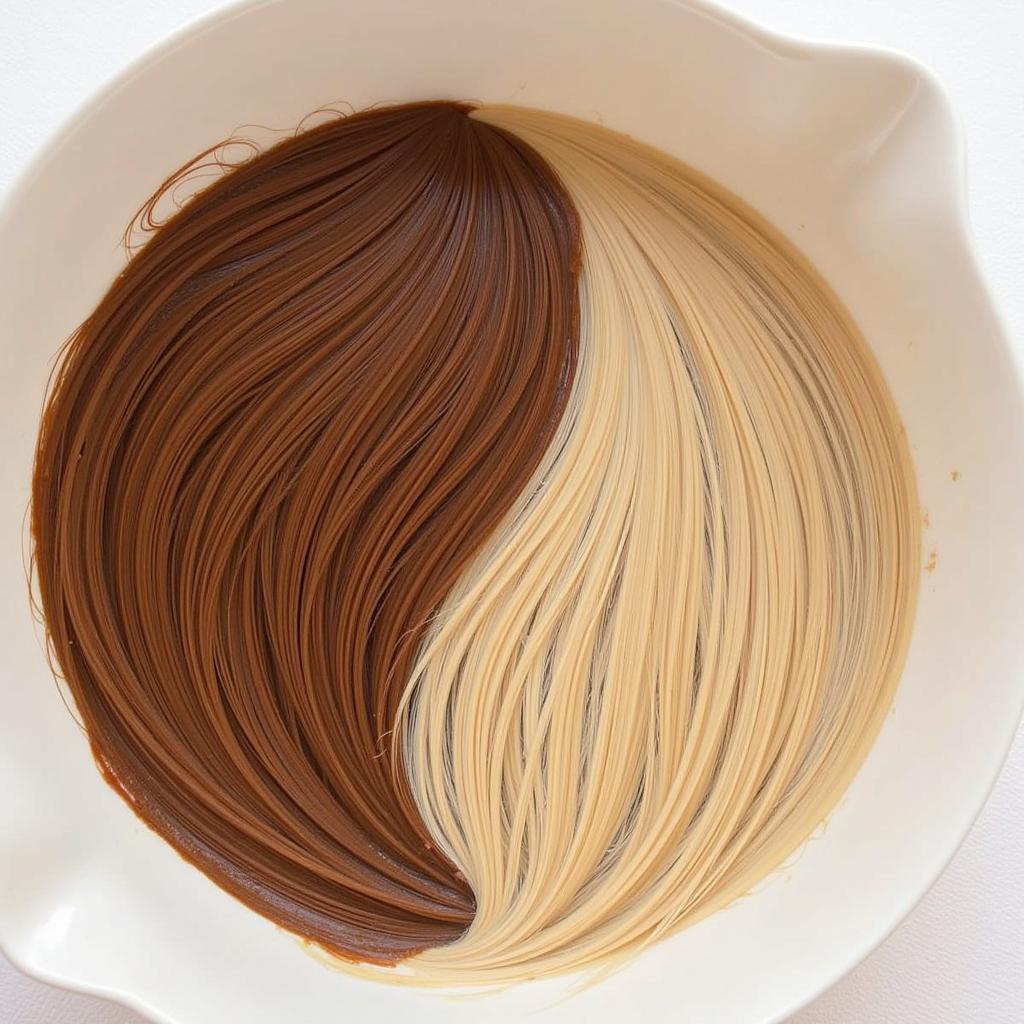You’re staring into your bathroom mirror, a box of hair dye in each hand, wondering: “Can You Mix Hair Color Brands?” It’s a question many of us have pondered, enticed by the possibility of creating a unique shade from the comfort of our homes.
While the idea of concocting a custom hair color is tempting, mixing different hair dye brands is generally not recommended. Hair coloring is a science, with each brand formulating its products with specific ingredients and developer strengths. Combining different brands can lead to unpredictable results, from uneven color to hair damage.
Why Mixing Hair Color Brands Is Risky
 Mixing Different Hair Dye Brands
Mixing Different Hair Dye Brands
Here’s a deeper dive into why playing mad scientist with your hair color can be a recipe for disaster:
- Inconsistent Formulas: Hair dyes are complex cocktails of pigments, developers, and conditioning agents. Each brand uses its own proprietary blend, making it nearly impossible to predict how different formulas will interact.
- Unpredictable Color Outcomes: Mixing brands can lead to unexpected and often undesirable color results. Instead of achieving that perfect auburn, you might end up with a muddy brown or, worse, a shade of green you didn’t sign up for.
- Potential for Hair Damage: Combining different developer strengths or incompatible ingredients can wreak havoc on your hair. You could experience anything from dryness and breakage to, in extreme cases, hair loss.
Safer Alternatives to Mixing Hair Color Brands
So, what’s a color enthusiast to do? Here are some safer options to satisfy your hair color cravings:
- Consult a Professional: When it comes to hair color, nothing beats the expertise of a trained stylist. They understand color theory, developer strengths, and can expertly mix shades within a brand’s range to create your dream look.
- Explore Single-Brand Options: Many hair color brands offer a wide spectrum of shades and tones. Spend time browsing different brands and consult their color charts to find your perfect match.
- Try a Hair Color Filler: If you’re transitioning from a darker to a lighter color and need to even out porosity, consider using a hair color filler. These products help create a neutral base for better color absorption.
Can You Mix Different Shades Within the Same Brand?
 Mixing Different Hair Color Shades Within the Same Brand
Mixing Different Hair Color Shades Within the Same Brand
While mixing different hair color brands is a no-go, you might be able to mix different shades within the same brand.
However, even this approach requires caution. It’s crucial to:
- Choose Shades Carefully: Select shades that are close together on the color spectrum to avoid muddy or unexpected results.
- Follow Instructions Precisely: Adhere to the mixing ratios and processing times outlined in the product instructions.
- Perform a Strand Test: Always perform a strand test on a small, inconspicuous section of hair before applying the mixture to your entire head. This allows you to preview the color result and ensures compatibility with your hair type.
Expert Insight
“Hair color is a science and an art,” says renowned colorist, Emily Chen. “While experimenting with color can be exciting, it’s essential to prioritize the health and integrity of your hair. Mixing different brands is never advisable due to the unpredictable nature of the chemical reactions. Trusting a professional colorist is always the safest bet for achieving stunning and healthy hair color results.”
Conclusion
While the allure of creating a custom hair color at home is strong, remember that hair color is best left to the professionals, especially when it comes to mixing brands. Protect your hair and your desired color outcome by resisting the urge to play chemist. Opt for safer alternatives like consulting a stylist, exploring single-brand options, or carefully mixing shades within the same brand. Remember, a little caution goes a long way in achieving vibrant, healthy hair color that turns heads for all the right reasons.
FAQs
1. What happens if I mix hair dye brands with different developer strengths?
Mixing developers with varying volumes can lead to uneven lift, breakage, and unpredictable color results. It’s crucial to use developers within the same brand and at the recommended strength for your desired color level.
2. Can I mix a permanent hair dye with a semi-permanent dye?
While it’s technically possible, the results can be inconsistent. Permanent dyes contain stronger chemicals that can alter the performance of semi-permanent dyes, potentially leading to uneven color or fading.
3. I mixed hair color brands and my hair feels dry and damaged. What should I do?
Use a deep conditioning treatment to help restore moisture and repair damage. Consult a stylist for further advice on repairing your hair and achieving your desired color.
4. Can I mix hair color brands if they are both ammonia-free?
Even ammonia-free dyes can contain different ingredients that may not be compatible. It’s still not recommended to mix brands, even if they share some similarities.
5. I’m unsure about my desired hair color. How can I get professional guidance?
Schedule a consultation with a reputable hair colorist. They can assess your hair type, discuss your color goals, and recommend the best products and techniques for achieving the look you desire.
Still have questions about mixing hair color brands?
Check out these related articles for more information:
- Can you mix different hair color brands?
- How long is hair color good for after mixing
- How do you mix Wella Color Charm
- What color is coconut milk
- What is a hair color filler
Contact us at Phone Number: 0373298888, Email: [email protected], or visit us at 86 Cầu Giấy, Hà Nội. Our customer service team is available 24/7 to assist you.

